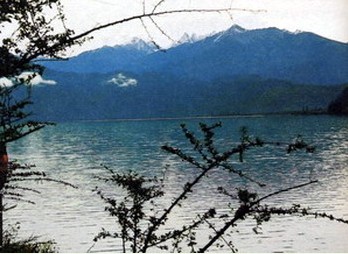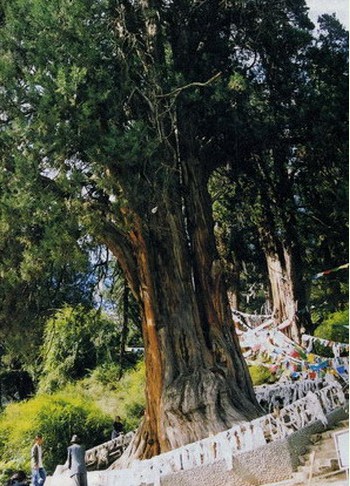In mid-August of 1974, I set off with the scientific expedition team in Lhasa of Tibet and reached the Nyang River Valley by way of Minla Mountain Pass with an elevation of 5400 meters. Not far from above Gongbo’gyamda County, the middle Nyang river valley became gradually wide. When reaching the river mouth in the Bayi Village, we found the width of the river valley could be 2~3 kilometers, with 2~3 terraces on both sides of the bank. Plenty of highland barley and wheat was grown on this fertile land, while beside those scattered villages, there were luxuriant walnut and apple trees. This region is a place suitable for apples, pears, peaches, walnuts and some other fruits to grow, and is also the main producing place of Tibetan apples. Those walnuts with good quality are also regarded as the tribute.
 |
| Photo: The scenery of Nyang’s wide river valley |
The 230-km-long Nyang River, a north tributary of the Yarlung Zangbo River, covers a drainage area of 17500 square kilometers. Although it ranks fourth among all the tributaries of the Yarlung Zangbo River, the branch is abundant in water amount, next only to the Parlung Zangbo River. Because of the humid Indian Ocean monsoon, glaciers here develop very well, providing abundant water sources for the Nyang River. The annual runoff in the river amounts to 22 billion cubic meters. The vegetation coverage rate is more than 34%, thus, there is little sediment concentration in the Nyang River. Even in the flood season, the river is still comparatively green and limpid. The reflected image of snow peaks and green mountains in the river shows a charming and beautiful scenery. This region is rich in forest resources, constituting a major part of forest area in Southwest China. As to the Tibet Plateau, it is a natural green ecological protective screen to conserve water source, regulate climate and protect the mountainous environment of east Tibet.
 |
| Photo :Basomtso surrounded by snow-capped mountains and green forests |
We felt comfortable and pleasant when we came to the Nyang River basin, because of green trees and grasses all over the mountains and valleys. Especially Bayi Village, located in the river valley of only 3000 meters above sea level, has a pleasant moderate temperature and humidity. The average annual temperature here is about 8 degrees centigrade, and the annual precipitation is 600~900 mm. The Nyang River basin, different from the dull, rough and wild desert scenery in Lhasa and Xigaze, has a rural scenery with green mountains and clear water, where people can feel joyful and delighted. Not far from Nyingchi, the upper Bahe River has a beautiful lake known as Basomtso, which is a local scenic spot formed by glaciers at 3583 meters above sea level.
The beautiful Nyang River basin is a green treasure-house. Besides the plentiful products, there are many dragon spruces and firs, as well as musk, glossy ganoderma, hericium erinaceus, poria cocos, edible tree fungi and matsutake. Among them, musk is praised as “western perfume”, as it is big and has thin shell with strong fragrance and good quality.
 |
| Photo Huge cypress in Bajie |
The musk is regarded as high ranking perfume, as well as widely used in medical science as stimulant and cardiac stimulants. Because of its preciousness, people caught and killed musk deer arbitrarily, which caused the quantity of the musk to reduce gradually in recent years. This situation made people worried, so it was extremely urgent to take effective measures to protect wild animal resources. It was said that there were lots of birds in the forest, such as Tibetan eared pheasants, tragopan, golden pheasant, and thrush. It is a pity that we did not have enough time to do more research into the deep forest, because our main task was to investigate the Grand Canyon, and we had to finish this job before cold weather came and the heavy snow sealed the mountain passes. For the same reason, we did not have time to visit Bajie village nearby, where there was an old huge cypress forest covering more than one hundred acreage, which was regarded as “the supernatural tree”. We heard that, among these cypresses, there was a “cypress king” with a diameter of up to 6 meters, which could be embraced hand in hand by more than ten people. As the “the living historical relic”, it was above 2500 years, even older than the famous “Han cypress” and “Tang cypress”. Although we did not have the chance to see it, we had seen this specific king of huge cypress at the river section from Nangxian County to Mainling County in the middle reaches of Yarlung Zangbo River. However, we have never seen such an old and huge cypress in the Bajie village. The scientific name of this huge cypress is Yarlung Zangbo cypress, also named as “beautiful cypress”, belonging to gymnosperm cypress subject. Featured by light loving, drought and infertility tolerance as well as good adaptability, it can grow very well on the alkaline sandy soil, with annual precipitation of less than 500 millimeters and the annual mean temperature of 8 degrees centigrade. It is famous for good material, corruptible-resistant feature, smooth surface and sweet fragrance. This kind of cypressmaterial can be used for the purpose of construction. In addition, the essence can be obtained from its branches and leaves, and oil can be extracted from its seeds to cure diseases such as palpitation, insomnia and amnesia. The bark can be used as rubber after it is refined. Thus, it is renowned as “the treasure tree” because it is widely used.
Bayi Village, at which we stayed during the expedition, was a newly built town, where stands the first large modernized Nyingchi Woolen Factory set up after the peaceful liberation of Tibet. Following Premier Zhou Enlai's instruction in 1966, Shanghai Fiber Factory and other small factories merged together, and then moved to Tibet and settled down by the beautiful Nyang River. The formerly barren land had already developed into the largest industrial city in Tibet. Its woolen textile goods such as woolen blanket and woolen textile fabrics were quite popular and sold very well at home and abroad.
LI Mingsen, The Institute of Geographic Sciences and Natural Resources Research
 Brief introduction to the author: Li Mingsen, a geographer, graduated from the Geology and Geography Department of Beijing University in 1963. As a researcher of the Commission for Integrated Survey of Natural Resources (one of the two mergers of the Institute of Geographic Sciences and Natural Resources Research in 1999), he has taken part in several scientific expeditions to Southwest China and the Qinghai-Tibet Plateau during the past 40 years. Since 1973, he has been to the Qinghai-Tibet Plateau more than 20 times, and left his footprints in the Himalayas, Yarlung Zangbo Grand Canyon, Qangtang no-human zone and Hengduan mountain region.
Brief introduction to the author: Li Mingsen, a geographer, graduated from the Geology and Geography Department of Beijing University in 1963. As a researcher of the Commission for Integrated Survey of Natural Resources (one of the two mergers of the Institute of Geographic Sciences and Natural Resources Research in 1999), he has taken part in several scientific expeditions to Southwest China and the Qinghai-Tibet Plateau during the past 40 years. Since 1973, he has been to the Qinghai-Tibet Plateau more than 20 times, and left his footprints in the Himalayas, Yarlung Zangbo Grand Canyon, Qangtang no-human zone and Hengduan mountain region.
